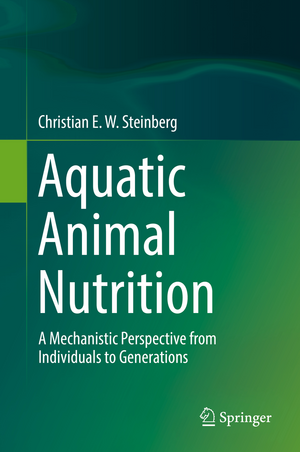Aquatic Animal Nutrition: A Mechanistic Perspective from Individuals to Generations
Autor Christian E. W. Steinbergen Limba Engleză Hardback – 6 oct 2018
This volume defines gaps in nutritional research and practice of farmed fishes and invertebrates by referring to knowledge from marine and freshwater biology. It also points out that dietary benefits and deficiencies have effects on several succeeding generations, indicating that well designed diets may have the potential to successfully improve broodstock and breeding effort.
| Toate formatele și edițiile | Preț | Express |
|---|---|---|
| Paperback (1) | 736.16 lei 43-57 zile | |
| Springer International Publishing – 28 dec 2018 | 736.16 lei 43-57 zile | |
| Hardback (1) | 1014.76 lei 43-57 zile | |
| Springer International Publishing – 6 oct 2018 | 1014.76 lei 43-57 zile |
Preț: 1014.76 lei
Preț vechi: 1237.51 lei
-18% Nou
Puncte Express: 1522
Preț estimativ în valută:
194.22€ • 200.16$ • 163.97£
194.22€ • 200.16$ • 163.97£
Carte tipărită la comandă
Livrare economică 03-17 martie
Preluare comenzi: 021 569.72.76
Specificații
ISBN-13: 9783319917665
ISBN-10: 3319917668
Pagini: 454
Ilustrații: XXI, 474 p. 269 illus., 154 illus. in color.
Dimensiuni: 155 x 235 mm
Greutate: 0.87 kg
Ediția:1st ed. 2018
Editura: Springer International Publishing
Colecția Springer
Locul publicării:Cham, Switzerland
ISBN-10: 3319917668
Pagini: 454
Ilustrații: XXI, 474 p. 269 illus., 154 illus. in color.
Dimensiuni: 155 x 235 mm
Greutate: 0.87 kg
Ediția:1st ed. 2018
Editura: Springer International Publishing
Colecția Springer
Locul publicării:Cham, Switzerland
Cuprins
Chapter 1. Introduction: ‘You Are What You Eat’.- Chapter 2. Diets and Digestive Tracts: ‘Your Food Determines Your Intestine’.- Chapter 3. The Intestinal Microbiota:‘Your Eating Feeds a Plethora of Guests’ and ‘This Plethora of Guests Determines Who You Are and How Well You Do’.- Chapter 4. Dietary Restriction, Starvation, Compensatory Growth: ‘Short-Term Fasting Does Not Kill You: It Can Make You Stronger’.- Chapter 5. Chrononutrition: ‘The Clock Makes Good Food’.- Chapter 6. Transgeneratinal Effects: ‘Your Offspring Will Become What You Eat’.- Chapter 7. Trophic Diversification and Speciation: ‘Your Eating Fuels Evolution’.
Textul de pe ultima copertă
This book is a unique cross fertilization of aquatic ecology and aquaculture. It shows how diets structure the digestive tract and its microbiota and, in turn, the microbiota influences life history traits of its host, including behavior. Short-term starvation can have beneficial effects on individuals themselves and succeeding generations which may acquire multiple stress resistances – a mechanism strengthening the persistence of populations. From terrestrial, but not yet from aquatic animals, it is understood that circadian the rhythmicity makes toxins or good food. On the long-term, the dietary basis impacts succeeding generations and can trigger a sympatric speciation by (epi)-genetics.
This volume defines gaps in nutritional research and practice of farmed fishes and invertebrates by referring to knowledge from marine and freshwater biology. It also points out that dietary benefits and deficiencies have effects on several succeeding generations, indicating that well designed diets may have the potential to successfully improve broodstock and breeding effort.
This volume defines gaps in nutritional research and practice of farmed fishes and invertebrates by referring to knowledge from marine and freshwater biology. It also points out that dietary benefits and deficiencies have effects on several succeeding generations, indicating that well designed diets may have the potential to successfully improve broodstock and breeding effort.
Caracteristici
Unique cross fertilization of aquatic ecology and aquaculture Defines gaps in nutritional research and practice of farmed fishes and invertebrates Comparative and broad taxonomic coverage of aquatic animals Comprehensive coverage of mechanisms at three levels
